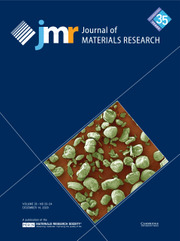Article contents
Processing of mesoporous alumina from a powder precursor
Published online by Cambridge University Press: 31 January 2011
Abstract
Oxides with significant mesopore volume can be produced from gels through ambient pressure drying (APD) if the oxide network within the gel is sufficiently strong. To obtain a strong alumina gel, a commercial alumina powder (100 nm diameter) was combined with different amounts of ethanol, water, and acid. Significant mesoporosity was observed in dried and calcined gels prepared from this precursor and ethanol alone, particularly when “poor wettability” was established in the gel through azeotropic distillation in toluene. When water (or water and nitric acid) was also utilized the pore volume decreased dramatically; this observation may be attributed to the creation of amorphous alumina from the crystalline precursor that is displaced into the interparticle pores, and in which mesopores are poorly preserved during APD.
Information
- Type
- Articles
- Information
- Copyright
- Copyright © Materials Research Society 2001
References
REFERENCES
- 1
- Cited by

